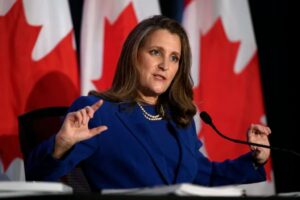Seniors, renters and low-income workers to get financial boost from government to help survive inflation


Millions of Canadians will get more money this year from the federal government as part of its plan to fight inflation, including $500 payments for nearly one million renters and up to $766 more for seniors over three million .
Deputy Prime Minister and Finance Minister Chrystia Freeland on Thursday announced an $8.9 billion plan to help Canadians tackle record-breaking inflation.
The plan includes increasing subsidies for workers and pensioners, cutting childcare fees, and promoting low-income renters. It also includes the first phase of a promised dental care plan for Canadians earning less than $90,000.
advertisement
Here’s what you need to know about Canada’s Affordability Plan.
Who benefits?
– Advertisement –
Aaron Woodrick of the Macdonald-Laurier Institute said that while everyone is feeling the pressures of inflation, the government is specific to try and address the most vulnerable among Canadians, such as low-income workers and renters and older seniors. targeting groups. These funds will help a lot of people a little, but they will not ease the pain of inflation in the long run, he added.
“I think we are in for a rough ride for the next six months to a year,” he said.
“It will help a little. But things that cause inflation haven’t gone away.”
It’s important to note that Thursday’s announcement is not a suite of new boosts to federal programs, but a re-packaging of funds already included in the latest federal budget, said David McDonald, director of the Canadian Center for Policy Alternatives (CCPA). ) a senior economist
However, that doesn’t mean these measures won’t help individuals and families combat inflation, he said – in particular, lowering child care costs will help many families.
Inflation by the Numbers, and What’s Next
Inflation rose 6.8 percent year over year in April 1981, with grocery prices seeing the biggest increase since September 1981 at nearly 10 percent. Gas was a major driver of inflation, up 36 percent, and experts said that if the war in Ukraine continued – which it has – consumers should expect high prices at the pump and grocery store to continue, as the war raged. have affected gas prices and grain products in particular. Meanwhile, wages rose at half the pace of prices.
The Bank of Canada is raising its overnight rate at an alarming pace in an effort to cool the housing market to balance inflation in other regions.
Woodrick said inflation in May, whose figures are due out next week, will remain high, with gas and food being the main drivers as the war continues in Ukraine.
In a speech in downtown Toronto on Thursday afternoon, Freeland pointed to Canada’s low unemployment rate as evidence of a strong economic recovery from COVID-19.
But despite strong employment, Freeland acknowledged that inflation is making it difficult for Canadians to afford daily living.
“Jobs are plentiful and business is booming, but it’s also hard for a lot of Canadians to pay their bills at the end of the month,” she said.
“We will take real and concrete steps to bring inflation under control and make life more affordable for Canadians.”
Low-income workers get up to $1,200, and renters $500. see you
Under the government’s plan, Canada Workers Benefit — a refundable tax credit for low-income workers — would be increased to $1.7 billion. That means nearly three million Canadians would receive $1,200 per person, or $2,400 more for a couple, according to the government.
Meanwhile, nearly a million low-income renters will receive a one-time payment of $500 this year.
Seniors get an extra boost this summer, up to $766 more—plus benefits are indexed
For senior citizens aged 75 years and above, there will be a 10 per cent increase in Old Age Security (OAS) pension in July 2022. This is on top of a 4.9 percent increase in the OAS and the Guaranteed Income Supplement (GIS) indexed for inflation. ,
Many benefits are indexed for inflation, namely OAS, GIS, Canada Pension Plan, Canada Child Benefit and GST Credit.
Macdonald said major federal programs are indexed for inflation, but that indexing is delayed enough, meaning recipients won’t see the payments right away.
Macdonald said that for OAS and GIS, indexation is three to six months behind, while for other benefits it takes a year.
“They’ll catch up eventually,” he said.
But he believes the government should have accelerated the listing of those programs to help recipients in the short term.
Families stand to save thousands in child care and dental coverage
Reforms in dental coverage and child care were already in the works, but Thursday’s announcements gave more details about the changes to come.
Now that agreements are in place with all 13 provinces and territories, childcare fees are expected to drop by an average of 50 percent this year, according to the government. That would mean savings of thousands of dollars for Canadian households in 2022, the government estimates, up to $6,000 in British Columbia, and up to $10-a-day for all regulated child-care locations across Canada by 2025-26. Average fee plan. ,
“Our plan makes work and life more affordable for middle-class Canadian families,” Freeland said.
Meanwhile, a dental coverage plan for Canadians earning less than $90,000 per year will begin in 2022 for children under 12.
Anyone can read the conversation, but in order to contribute, you must be a registered Torstar account holder. If you don’t have a Torstar account yet, you can create one now (it’s free)
The conversation is the opinion of our readers and is subject to Code of conduct. Star does not endorse these views.
#Seniors #renters #lowincome #workers #financial #boost #government #survive #inflation




